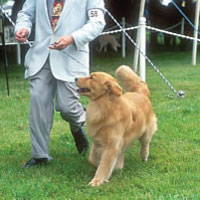Q: How do I move from food treats to praise only?
A: This question is often asked by pet owners or crossover trainers who are wary of being overly reliant on food in training and by competition obedience trainers who know they can't use food in the ring.
All treats, all the time

I reply to each the same way: if your dog does the work, he deserves a paycheck. Praise can be an effective reinforcer, but most dogs are unwilling to work for praise alone. This means that if you want to maintain the strength of the behavior you must continue to reward it, even if you're training for competition.
Patty Ruzzo, an extremely successful competition trainer, is often asked about "fading"—phasing out-food treats before competition. She says, "If you knew a famine was coming, would you starve your children to prepare them for it?" Of course not! You'd feed them!
The only time you can't reinforce your dog with food is during the trial performance itself. Think how many times you practice the required behaviors ahead of time. Actual performance is a small percentage of that total. Why deprive yourself of one the most powerful-not to mention incredibly convenient-reinforcers available to you during training?
Realities of the ring
All that said, you do need to phase in alternative reinforcers at some point, so the dog won't go into total shock in the ring. And if you're a pet owner, you'll sometimes need to use alternative rewards so your dog will remain happy and willing even when you don't have food available.
As noted earlier in this chapter, you have a whole slew of reinforcers available to you. Once you've chosen your alternative rewards it's time to phase them in like any other criteria-starting slow and building gradually over time. Here's a series of steps you might use:
- Do ten repetitions, or "reps," reinforcing with food after each one.
- Do ten reps. Reinforce with food after nine of them, with an alternative reinforcer after one. (Which one? Randomize. Number ten slips of paper, put them in a hat, mix them up, and draw one to determine which rep you'll reward with the alternative reinforcer. For example, you draw number three, so you do two reps with food, then use the alternative reinforcer on the next one, then reinforce with food for the remainder of the session.)
- Do ten reps, reinforcing with food after eight of them, with an alternative reinforcer for two. Randomize to determine which two.
- Do ten reps. Reinforce with food for seven and use an alternative reinforcer for the other three.
And so on. If you've properly conditioned your alternative reinforcers, there should be no lessening of attitude, since you're still using a reward of value. If there is a change in attitude, go back to basics and try to increase the value of your reinforcer more gradually.
One final word: Just because your dog now understands that the behavior may not be followed by a food treat doesn't mean you should cut out food treats entirely. Think of training along a bell curve; for every time you train without food, you should have a session using food only, and most sessions should fall somewhere in the middle-sometimes a few more food rewards, sometimes a few more alternative rewards. Be unpredictable!



Thanks for the great article.
Thanks for the great article. I compete with my dogs in obedience regularly and what I have found very helpful is when practicing to leave food on the ground as a distraction. Then after their performence, I release them to the food. It transfers to a ring situation very easily. I leave the treats outside the ring and ask dog to leave it. Dog comes into ring with me and after the performence dog is released to eat treat. This has worked very well for me and the my dogs understand the concept very well.
Fading out treats
Thanks Melissa. Great article. I was wondering how I was going to phase out treats with my dog. Your program is very easy to follow.
Training for delayed reward
Dawn Jecs has a program for "training" the delayed reward that seems worth a try. It is outlined in "choose to heel". I just got it on cassette, but can only listen to it when I borrow my friend's car, lol. I would hesitate to outline it here because I've only listened to it once so far, but I like the concept. It is taught separately from other behaviours.
Fading
Wonderfully written article. Thanks, Melissa. This is just the help I was needing with clear examples of how to proceed.
Diane Filler
Post new comment